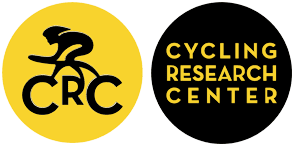Angular Kinematics and Critical Power of Younger and Older Cyclists during the 3-Min All-Out Test
DOI:
https://doi.org/10.28985/1322.jsc.03Keywords:
work; VO2; range of motion, steady state cyclingAbstract
This study aimed to determine differences in angular kinematics and critical power between younger and older cyclists during the 3-min all-out test. Younger (n = 15, 21.8 ± 2.4y) and older (n = 15, 53.3 ± 6.6 y) Category 1 or 2 riders completed maximal aerobic testing and a 3-min all-out test on separate days using their own bicycle on a cycle ergometer. Eight retroreflective markers determined right side sagittal plane angular kinematics during the 3-min all-out test. Younger cyclists displayed higher VO2max, VO2 @ VEbp, HRmax, Power @ VO2max and Critical Power (p < 0.05) than older cyclists. Cadence decreased over time for the combined group (time 1 (T1) = 87.3 ± 4.5 rpm, time 2 (T2) = 83.7 ± 4.6 rpm, and time 3 (T3) = 83.6 ± 5.0 rpm) where T1 was significantly higher than T2 and T3 (p < 0.001), but there were no differences between age groups. Ankle (T1 > T2 > T3, p < 0.026) and foot ranges of motion (T1, T2 > T3, p < 0.01) decreased over time for both age groups. Additionally, younger cyclists had larger ankle and foot ranges of motion (ROM) compared to older cyclists (p = 0.036 and p = 0.032, respectively). Age related differences in physiological measures occurred as expected, although the skill level of the cyclists may explain their similar cadence. Smaller ankle and foot ROM may be strategies to assist force and power generation, particularly in older cyclists as they attempt to overcome aging related physiological declines. With smaller ROM, older cyclists may aim to strengthen ankle musculature and deemphasize high cadence to maintain force generation and critical power.
Downloads
Published
How to Cite
Issue
Section
Copyright (c) 2022 Journal of Science and Cycling

This work is licensed under a Creative Commons Attribution-NonCommercial-NoDerivatives 4.0 International License.
Authors contributing to Journal of Science and Cycling agree to publish their articles under a Creative Commons CC BY-NC-ND license, allowing third parties to copy and redistribute the material in any medium or format, and to remix, transform, and build upon the material, for any purpose, even commercially, under the condition that appropriate credit is given, that a link to the license is provided, and that you indicate if changes were made. You may do so in any reasonable manner, but not in any way that suggests the licensor endorses you or your use.
Authors retain copyright of their work, with first publication rights granted to Cycling Research Center.






